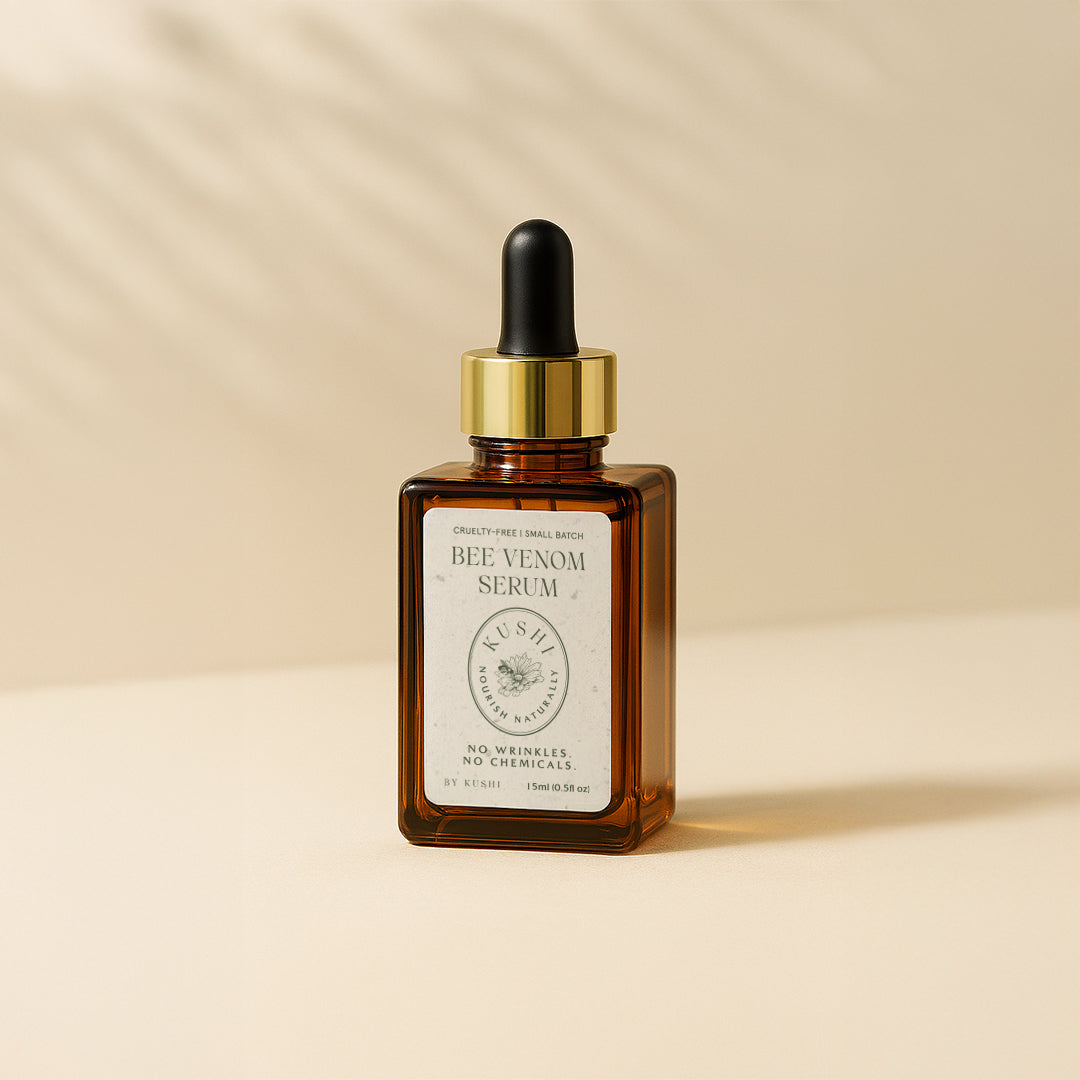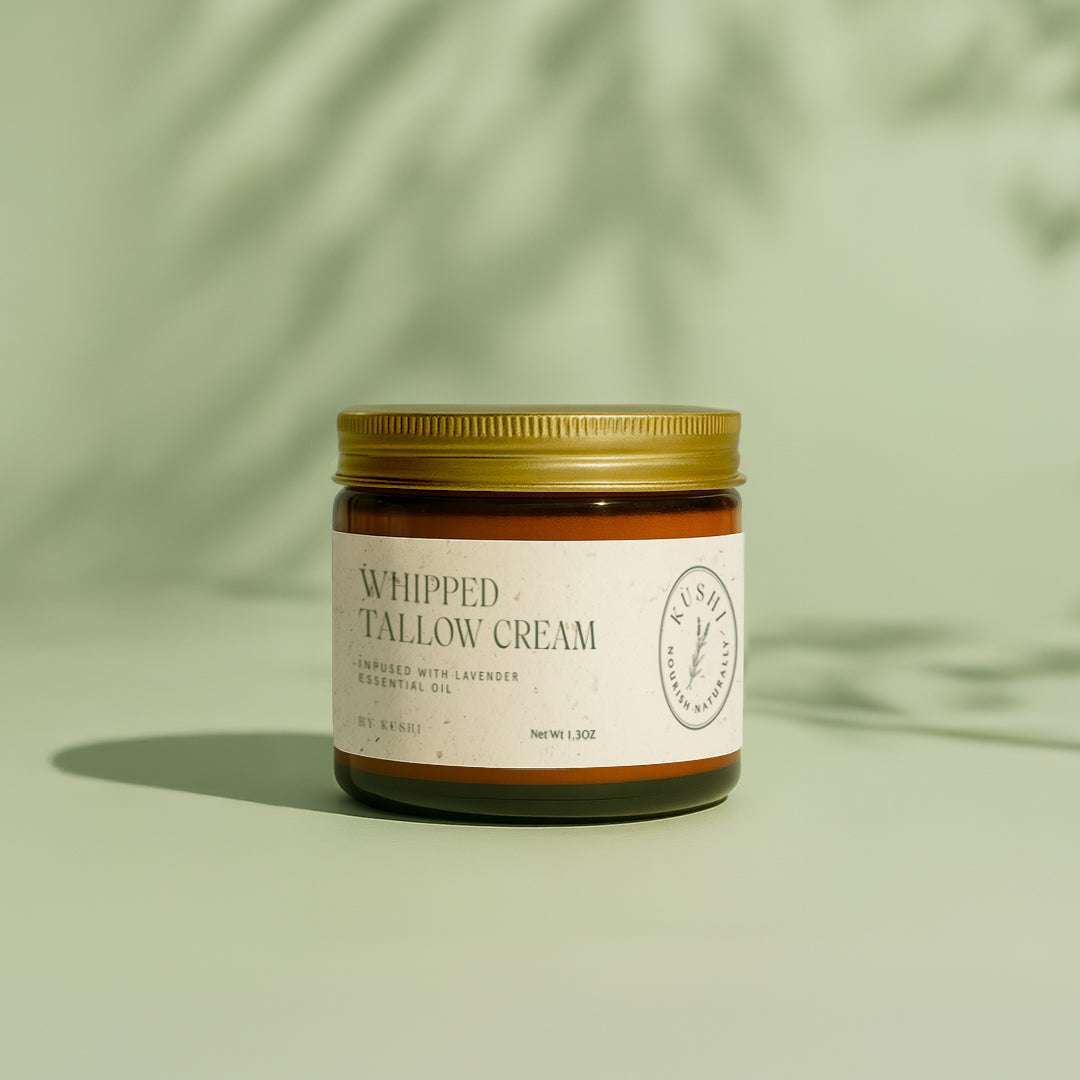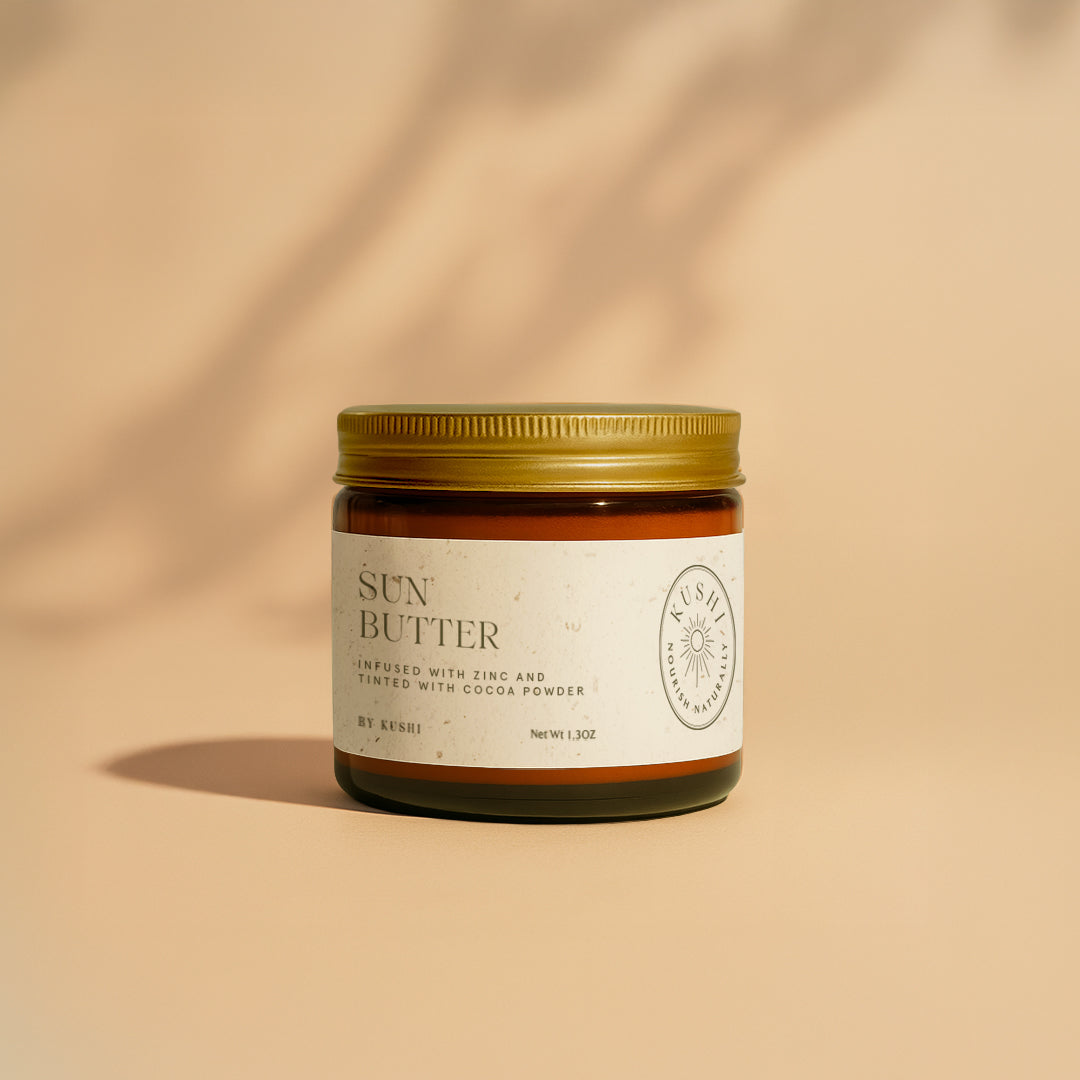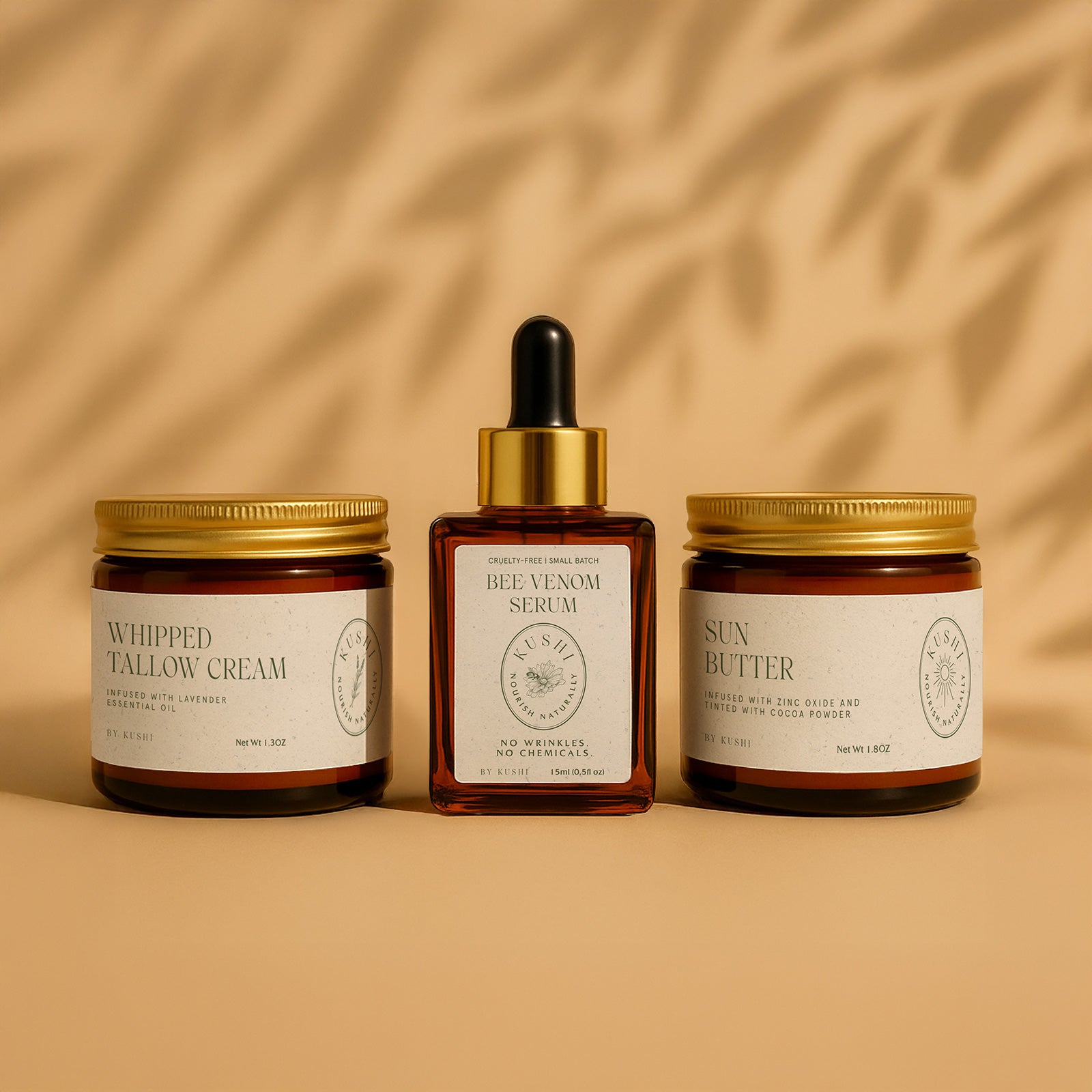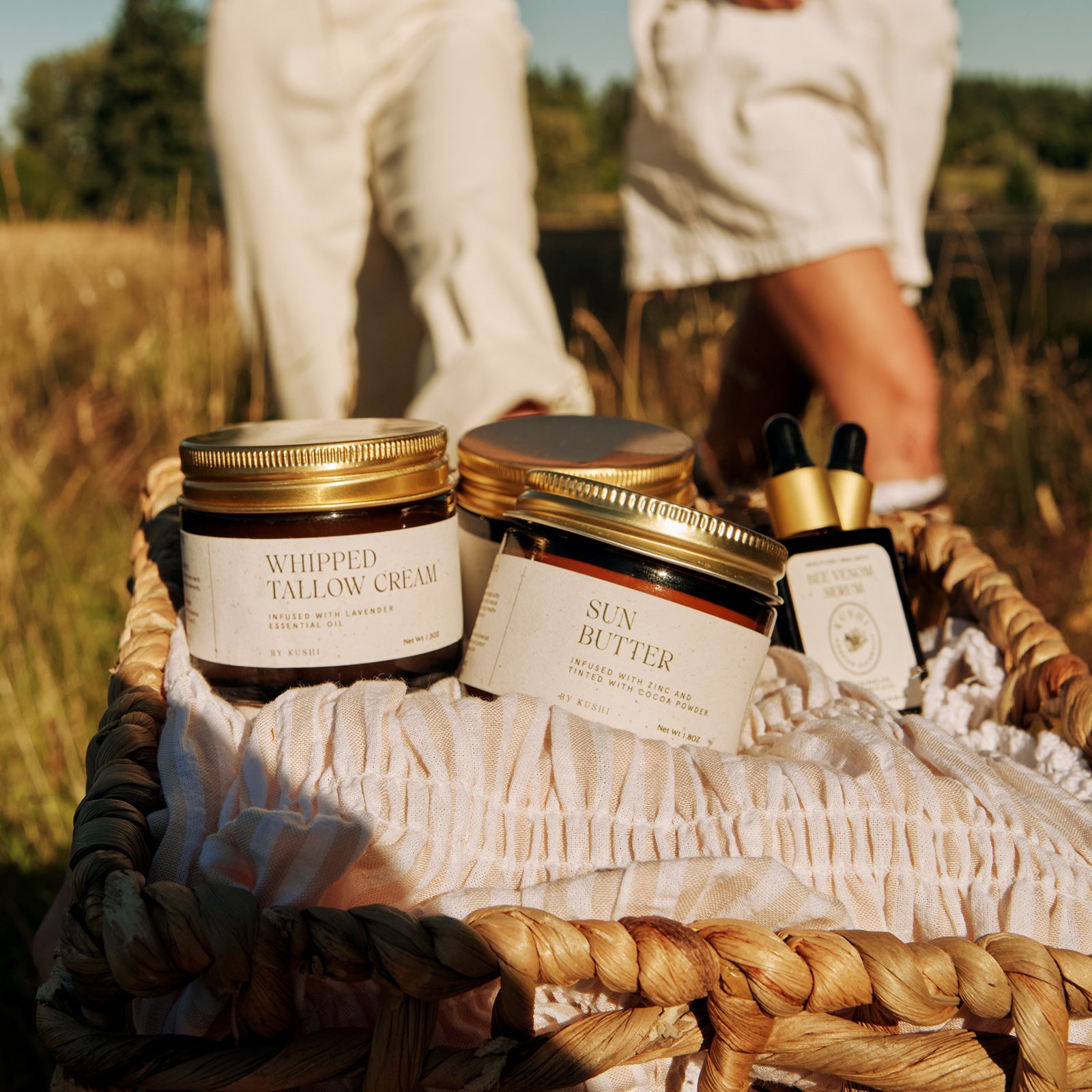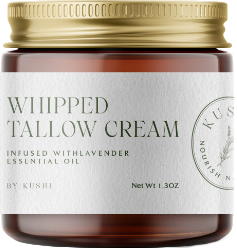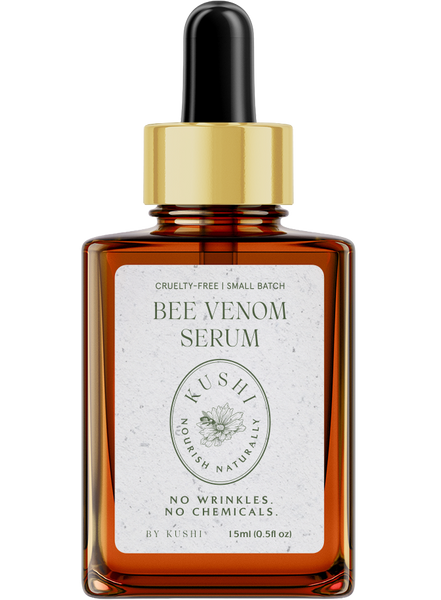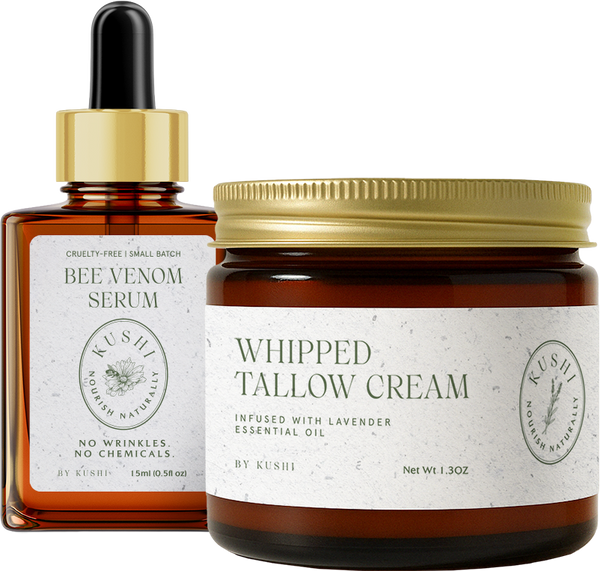Key Takeaways:
-
Skin-Like Structure: Tallow’s lipid structure closely mimics the skin’s natural oils, making it highly absorbable and effective at restoring balance. This natural compatibility reduces the risk of irritation or buildup.
-
Moisture That Repairs: Unlike coconut oil, which primarily sits on the skin’s surface, tallow penetrates deeply to hydrate and support real healing. It strengthens the skin barrier rather than masking symptoms of dryness.
-
Anti-Inflammatory Power: Tallow contains naturally occurring compounds like CLA and palmitoleic acid that calm inflammation and redness. This makes it a soothing option for conditions like eczema, acne, and rosacea.
Can your moisturizer tell a story rooted in tradition, purity, and healing?
In overcomplicated skincare routines and lab-made formulas, many are returning to simple ingredients their ancestors might’ve used. The conversation around beef tallow vs coconut oil is more than a trend; it's a reflection of the growing desire for skincare that nourishes without compromise. For those dealing with dryness, irritation, or chronic skin conditions, the choice between these two natural options can make a world of difference.
At our small-batch, grass-fed skincare studio, we craft whipped tallow cream with reverence for nature and ancestral wisdom. We don’t follow fads; we follow the purity of earth-derived, bioavailable ingredients that work in harmony with your skin. That’s why we stand by tallow: it is rich in essential vitamins, completely free from synthetics, and deeply compatible with the skin's own structure.
In this piece, we’ll explore the key differences between beef tallow and coconut oil for skincare, breaking down their nutrient profiles, how they interact with sensitive skin, and why tallow is a superior choice for lasting hydration and healing.
What Is Beef Tallow?
Beef tallow is a rendered form of fat sourced from cattle, traditionally used for everything from cooking to candle-making. But when it comes to skincare, its value runs deeper. Grass-fed beef tallow is rich in fat-soluble vitamins A, D, E, and K—critical nutrients that support skin regeneration, hydration, and barrier repair.
What sets tallow apart is its molecular similarity to human sebum. This means it absorbs easily, delivering nutrients directly into the skin without clogging pores or leaving a greasy residue. In the context of beef tallow vs coconut oil, this natural compatibility gives tallow a distinct edge for those with sensitive or reactive skin types.
Our small-batch formulation only uses 100% grass-fed and finished tallow sourced from Canadian family farms. It’s gently whipped to create a light, creamy texture that melts into the skin—simple, effective, and deeply nourishing.
What Is Coconut Oil?
Coconut oil is extracted from the meat of mature coconuts and has become a staple in both kitchens and skincare routines. Its natural fatty acid content, particularly lauric acid, gives it antimicrobial properties and a smooth, moisturizing texture. For many, it’s an easy go-to for dry skin and hair.
But in the beef tallow vs. coconut oil conversation, there’s more beneath the surface. Coconut oil tends to sit on top of the skin rather than absorbing deeply, which can lead to clogged pores and breakouts, especially for acne-prone individuals. While it offers a temporary layer of moisture, it lacks the fat-soluble vitamins and skin-identical lipids that make tallow so deeply restorative.
Though coconut oil may seem like a simple, natural solution, it doesn’t always work well for sensitive or compromised skin barriers. For some, it can trigger irritation or congestion.
Healing And Moisturizing Benefits
When choosing a natural moisturizer, performance matters. It’s not just about how something feels on your skin in the moment; it’s about what it delivers beneath the surface. Let’s look at how beef tallow vs coconut oil compares when it comes to hydration and skin healing:
Deep Moisture That Lasts
Beef tallow mimics the skin’s natural oils, allowing it to absorb deeply and replenish moisture at a cellular level. Its saturated fats create a breathable barrier that locks in hydration without clogging pores. This makes it ideal for dry, flaky, or compromised skin that needs more than just a surface fix.
Nutrient-Rich Healing Support
Tallow is packed with bioavailable vitamins A, D, E, and K—nutrients that support skin regeneration and help soothe irritation. These fat-soluble compounds assist with cellular repair, making tallow a natural ally for conditions like eczema, psoriasis, and rosacea. Unlike coconut oil, tallow works with the skin to heal, not just to coat.
Coconut Oil: Surface Soothing, Limited Penetration
Coconut oil provides a smooth, emollient texture that temporarily softens the skin. However, it tends to sit on the surface and may clog pores or trigger breakouts in sensitive skin types. While it offers a mild antimicrobial effect, it lacks the deeper nourishment and skin-repairing vitamins found in tallow.
Sensitivity And Irritation: Which Is Gentler?
For those with sensitive skin or chronic skin issues, ingredient gentleness can’t be compromised. The debate around beef tallow vs coconut oil becomes especially important when skin reacts easily. Let’s explore how each ingredient behaves on fragile, reactive skin:
Skin Compatibility And Bioavailability
Beef tallow’s lipid profile closely resembles the natural sebum of human skin, making it highly bioavailable. This means the skin absorbs it effortlessly without resistance or irritation. Because of this natural compatibility, tallow is far less likely to trigger flare-ups or imbalances in sensitive skin.
Inflammation And Allergic Reactions
Coconut oil, though natural, can be problematic for reactive skin. It’s a known allergen for some individuals and has been reported to cause breakouts, rashes, or stinging in people with compromised skin barriers. Its lauric acid content, while antimicrobial, may also disrupt the skin’s natural balance.
Calming And Restorative Properties
Tallow contains natural anti-inflammatory compounds like CLA and palmitoleic acid that calm redness and reduce inflammation. These properties help soothe irritation instead of simply covering it up. For skin in distress, tallow offers a restorative effect, supporting recovery.
Why Tallow Wins For Sensitive, Problem-Prone Skin
Every ingredient matters when skin is prone to flare-ups, breakouts, or chronic dryness. The beef tallow vs coconut oil discussion becomes less about preference and more about results. Here’s why tallow rises to the top for those seeking relief, balance, and long-term skin support:
Supports Skin Barrier Function
Tallow works in harmony with the skin’s structure, helping to restore and strengthen the moisture barrier. A resilient barrier is key to preventing irritants from entering and moisture from escaping. With its natural fatty acid profile, tallow helps skin stay calm, balanced, and protected.
Non-Comedogenic For Most Skin Types
Unlike coconut oil, which can clog pores and worsen acne for many users, tallow tends to be non-comedogenic. It absorbs cleanly without creating a heavy film or trapping debris in the pores, making it an excellent option for acne-prone or inflamed skin.
Nourishment Without Harshness
Tallow delivers deep nourishment without relying on preservatives, artificial fragrances, or synthetic ingredients. Its simplicity is a major benefit for those with sensitive or allergy-prone skin. With tallow, there’s no overload—just essential nutrients the skin needs and can use.
How To Use Tallow In Your Skincare Routine
Switching to a natural product like tallow doesn’t require an overhaul—just a few intentional steps. Its versatility makes it easy to integrate into any clean skincare ritual. Here’s how to make the most of this deeply nourishing ingredient:
-
Start with Clean, Dry Skin: Always apply tallow to freshly washed skin so it can absorb fully and lock in moisture. Before application, use a gentle, non-stripping cleanser to avoid disrupting the skin barrier. Once dry, a small amount of tallow is enough to effectively coat and nourish the skin.
-
Use a Pea-Sized Amount: Tallow is rich and concentrated, so a little goes a long way. Warm it between your fingers to soften the texture before massaging it gently into the skin. Its whipped consistency allows for even, smooth application without heaviness.
-
Apply Day or Night (or Both): Use tallow as a daily moisturizer or as an overnight repair balm, depending on your skin’s needs. Many find it especially effective as a nighttime treatment to support healing while the skin regenerates. For daytime use, it layers well under minimal, non-toxic makeup or natural sun protection.
Final Thoughts
In a skincare landscape overflowing with options, the choice between beef tallow vs coconut oil ultimately comes down to what your skin truly needs—nourishment that aligns with its biology, not just trends. Tallow stands out not because it’s fashionable, but because it simply works. Its deep compatibility with human skin and its rich, natural nutrient content make it more than just a moisturizer—it’s a return to what skin care was always meant to be: honest, effective, and rooted in nature.
Choosing tallow means supporting your skin in the most natural way possible. It’s a commitment to fewer ingredients, deeper hydration, and long-term healing over short-term gloss. Whether you’re dealing with persistent dryness, sensitivity, or simply craving simplicity, tallow invites you to step away from the noise and give your skin something real.
Read also:
Frequently Asked Questions About Beef Tallow Vs Coconut Oil
Can beef tallow be used alongside coconut oil in a skincare routine?
Yes, you can layer or alternate them, though it depends on your skin type. Many people use tallow for deep nourishment and coconut oil for light cleansing or oil pulling. Be mindful that using both at once may overwhelm oily or acne-prone skin.
Which is more shelf-stable: beef tallow or coconut oil?
Coconut oil tends to have a longer shelf life at room temperature due to its saturated fat content and low moisture. When rendered and stored properly, Tallow is also kept well but may benefit from refrigeration if not used regularly. Both can go rancid if contaminated or exposed to heat and light.
Is coconut oil more sustainable than beef tallow?
Sustainability depends on sourcing. Coconut oil sourced from monoculture plantations can have a large environmental footprint, while grass-fed tallow from regenerative farms supports soil health and reduces waste. Ethically sourced tallow can be a more eco-responsible option.
Can beef tallow be used on oily or acne-prone skin types?
Yes, because tallow is non-comedogenic for most people and helps rebalance the skin’s oil production. It delivers nutrients without blocking pores or irritating active breakouts. Some people find it reduces inflammation and helps heal blemishes over time.
Does coconut oil go rancid faster than beef tallow?
Coconut oil is highly stable and resists oxidation, which helps extend its shelf life. Tallow may oxidize more quickly, especially if exposed to air or moisture. Proper storage in airtight containers away from heat can help both last longer.
Are there any cultural or historical uses of beef tallow in skincare?
Yes, traditional cultures have used beef tallow for centuries for skin healing and protection. Before commercial lotions existed, rendered animal fats were standard for winter skin care and wound treatment. Today, it remains a staple in ancestral skincare practices.
Can I use beef tallow as a lip balm or for chapped areas?
Tallow works exceptionally well on dry or cracked lips, elbows, and knuckles. Its rich, emollient texture helps protect and heal without artificial additives. A small amount provides long-lasting moisture and comfort.
How does each ingredient behave in different climates?
Tallow adapts well to colder, dry climates where skin often needs extra support, while coconut oil tends to liquefy in warm, humid environments. This can affect ease of use and absorption. For year-round performance, tallow tends to be more stable and consistent.
Does either ingredient support anti-aging benefits?
Tallow’s high content of vitamins A and E supports collagen production and cellular turnover, both key to maintaining skin elasticity. Coconut oil offers basic moisture, but lacks the depth of nutrients for long-term skin resilience. For visible skin aging, tallow provides more functional support.
What does the texture of beef tallow feel like compared to coconut oil?
Whipped beef tallow has a creamy, balm-like texture that melts into the skin without feeling greasy. Coconut oil, when solid, is firmer and can feel slick or oily once applied. Tallow offers a more velvety, matte finish that tends to absorb more fully into the skin.
